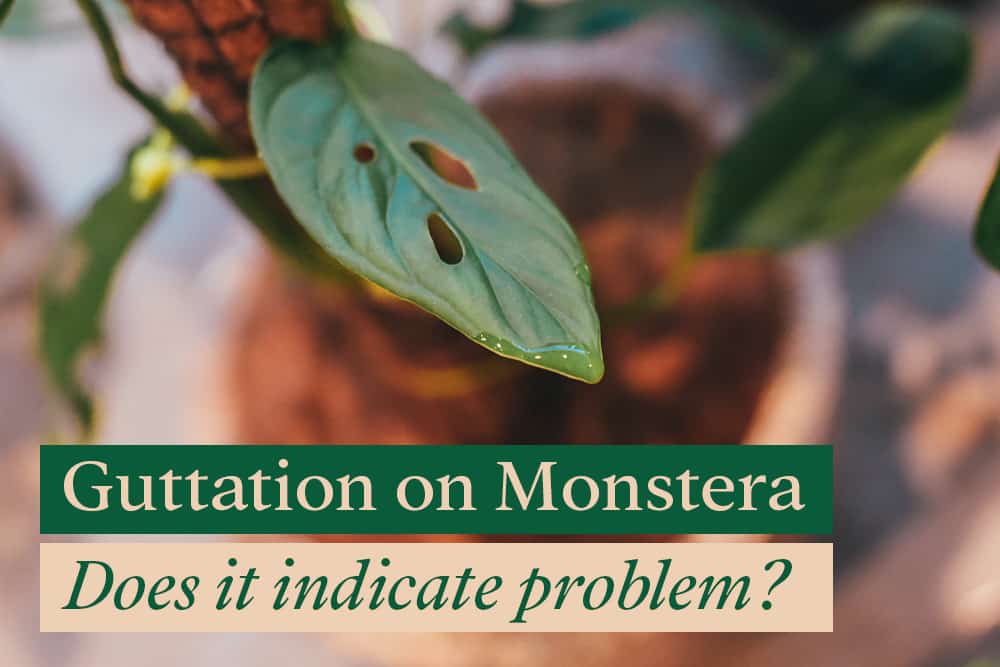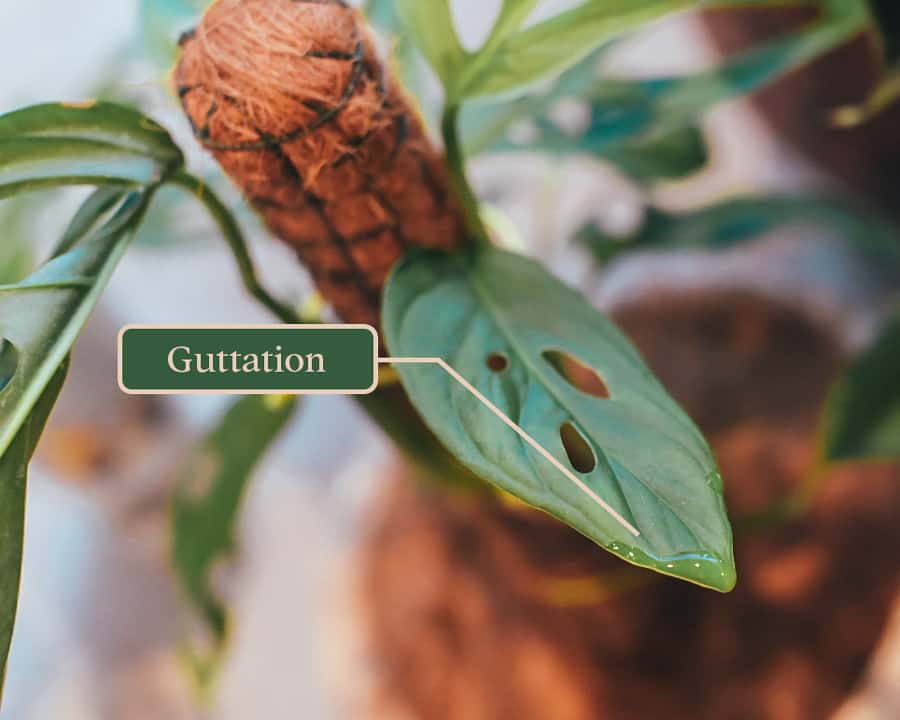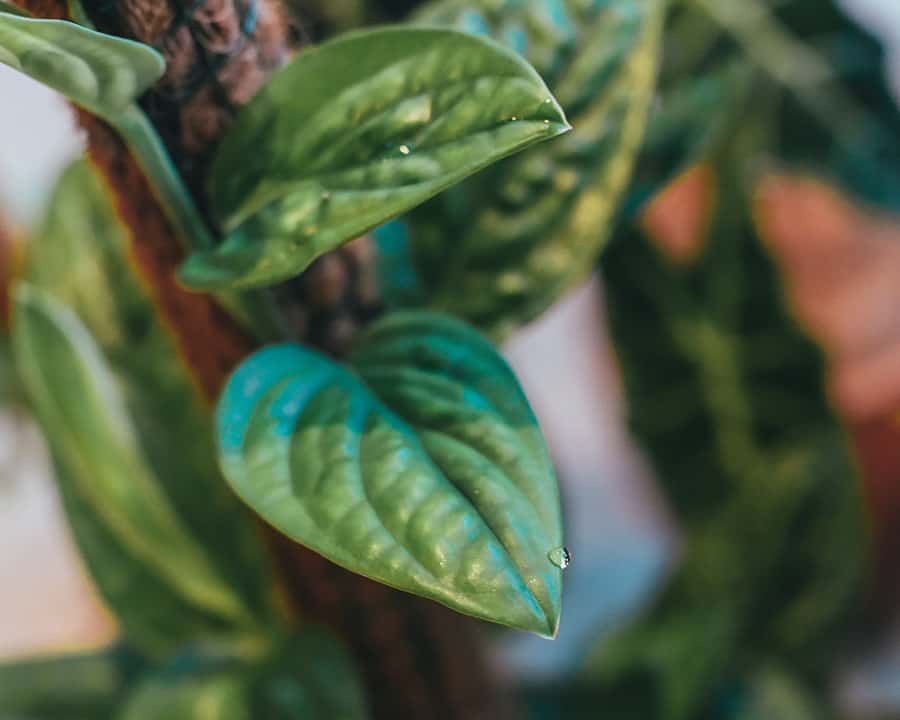
Do you see water droplets at the tips of your Monstera leaves? Have no fear! Your Monstera isn’t crying; it’s merely releasing excess water in a harmless, natural process known as guttation.
Guttation is Monstera’s biological process to get rid of excess water and nutrients. This process allows plants to balance their intake and output levels and continue to cycle minerals, sugar, and other vital chemicals throughout their systems at night.
Although harmless, it might indicate or promote some future problems. In this article, I will also discuss what to do to prevent guttation on your Swiss Cheese plant.
Let’s get started!
What does guttation look like?

Guttation occurs when droplets form at the tips and edges of plant leaves. These droplets are a combination of water and nutrients known as xylem sap and serve as a release for any excess the plant may have.
The guttation process begins at the plant roots as water and minerals are absorbed from the soil.
This intake builds up pressure in the roots, which forces chemicals, sugars, water, and any other elements upwards through a system of channels known as phloem.
Finally, small clusters of cells called hydathodes release the xylem sap from leaves’ ends and margins.
When a plant is oversaturated with water and nutrients, it utilizes guttation to remove these excesses to return to a state of balance.
Why does my Monstera sweat?
Sweating droplets could indicate that your Monstera is a little oversaturated with water and is looking to get rid of it. Your Monstera could be dripping for several other reasons. Still, in the majority of cases, it is nothing to worry about.
Guttation is a crucial process in the life of plants such as Monstera. It allows the plant to continue breathing and cycling nutrients throughout its leaves and stems even at night, when transpiration and evaporation processes are not as effective.
Monstera releases more than 90% of the water through transpiration and only removes 5% or less through guttation.
When to Find Guttation on Monstera?
Early Morning or Night time
During the day, your Monstera utilizes transpiration and evaporation to rid itself of extra water. We typically do not see this process because it occurs at a molecular level. However, at night these processes shut down, and Monstera uses guttation instead.
During Days with High Humidity and Moisture Level
When the air is above 90% relative humidity, it’s nearly impossible for plants to cycle sap through their typical processes.
Also, with such a high moisture content in the air, transpiration and evaporation are not possible. Thus, Monstera must use guttation to continue breathing in high humidity climates.
Excess Moisture in the Soil
If there is too much moisture in your soil, guttation can also occur. While Monstera is a relatively resilient species that can tolerate an occasional overwatering, that does not mean they enjoy it.
Monstera tends to experience guttation more often than other plants (particularly after watering), so if you notice guttation, it could be time to review your watering schedule.
If overwatering is not an issue, improper drainage could also be a source of excess moisture. You can check and see if the water can run out of the drainage hole at the bottom of your pot or if it is clogged.
To check if there is excess water in the soil, you can stick your finger into the soil. If the top 2 inches of the soil is dry, it is a good indication that your Monstera is ready for watering.
But if it is still moist, you can wait several days before watering again to reduce the chances of guttation.
Young Monstera tends to Experience Guttation More Often
Younger Monstera and seedlings also tend to guttate more than older plants, so it should not be a cause for concern if you notice guttation more often on your young Monstera.
Is Guttation Bad for Monsteras?

Guttation is a natural aspect of a plant’s life, and it doesn’t necessarily mean anything is wrong. In fact, guttation is necessary for Monstera to maintain health and balance within its internal ecosystem.
May Indicate Stress in Monstera
Still, it’s never a bad idea to check in with your Monstera’s overall health and environment. Some say that guttation is a result of inhospitable growth environments or stress. Even if you are doing everything you can to ensure a happy Monstera, each plant is unique and can vary in sensitivity levels.
Changes in the pot size, soil, and temperature will affect each Monstera differently depending on how sensitive your unique plant is.
Signs of Over Fertilization
Guttation can turn into a problem if you are over-fertilizing your Monstera or using too harsh fertilizers.
If you have a high mineral content in your soil, a white residue can build up once the water in the xylem sap evaporates, and you can get browning and burn on your leaves. You can quickly fix this by using less fertilizer.
Here is how to use effectively use fertilizer for your Monstera.
Can Promote Fungal Infection
Guttation can also serve as a site for fungal infection. Because clusters of hydathodes on the stems and leaves are frequently open, they can serve as a breeding site for fungal infection on your Monstera.
To prevent this, make sure your Monstera is receiving a good airflow, especially in humid climates.
Guttation is Safe for Pets and Harmless for Furniture
Fortunately, xylem sap is non-toxic and is harmless for your house, furniture, and pets. It will not leave stains, and if your pet ingests xylem sap, it should not be a cause for concern.
How to Prevent Guttation?
Guttation is not something that needs to be prevented and is not a cause for alarm. However, suppose you are concerned about your Swiss Cheese plant’s overall health and want to give it the best conditions to flourish.
In that case, there are several ways you can reduce guttation and its potential negatives:
Avoid Watering in the Evening or at Night
Transpiration and evaporation are much less effective in the evening. So guttation is the only way in which Monstera can rid itself of excess water.
Always try to water your Monstera in the morning, between 7 to 10 am.
Avoid Using Tap Water
Water your Monstera with soft water or rainwater, rather than hard tap water. Tap water tends to have a higher concentration of minerals, which could overburden your Monstera and lead to more guttation.
Suppose you do not have easy access to rainwater or soft water. In that case, you can leave tap water at room temperature for 24 hours to remove Chlorine and other harsh chemicals that increase the potential for guttation.
Avoid Over Fertilization
Monitor how much fertilizer you give your Monstera. If you over-fertilize your Monstera, it will result in more guttation as the plant will have more nutrients than it needs.
This excess will leave a white residue on the leaves once the water from the xylem sap evaporates, which can cause browning and burn over time.
You can switch to a less concentrated fertilizer or simply fertilize your Monstera less to prevent this.
Wipe Guttation Spots
Take care to wipe guttation spots off of the leaves gently with a moist cloth to aid your Monstera in ridding itself of excess minerals and nutrients to prevent browning.
Is Guttation the same as dew?
Guttation is different from Dew. Guttation is an internal process that Monstera goes through for their regulation and growth. In comparison, Dew is the result of humidity and water vapor from air condensing on plant leaves.
Dew rarely ever occurs indoors unless you leave it next to an open window at night.
Dew serves the opposite purpose of guttation for plants. Dew reduces water stress for plants that live in particularly hot, dry climates by forming protective barriers on leaves and allowing plants to retain more moisture. It can also keep plants cool as it evaporates.
Guttation, on the other hand, allows plants such as Monstera to release excess water. Both of these processes can work together to help plants maintain a water balance.
Why is my Monstera sticky?
Xylem fluid is not sticky, so if you notice sticky droplets on your plants, it is not the result of guttation. It could be a substance known as “honeydew”, which is composed of sugars and other nutrients that pests have secreted after feeding on your Monstera.
While honeydew itself is not harmful, the mites, mealybugs, and scale insects that secrete it can slowly and surely kill your plant over time. If you notice “honeydew” on your Monstera, you should give it a meticulous examination and work quickly to terminate unwanted pests.
Luckily, there are various methods to get rid of these pests without using harsh insecticides that could negatively affect your Monstera. You can typically dislodge mites with a jet of water from a kitchen syringe or a hose when the weather is warm. Just be sure to be thorough and altogether remove all clusters of mites.
Use neem oil as a reliable, natural insecticide to dispel mealybugs and scale insects. You can pick off scale insects using a toothpick or knife, and you can get rid of the majority of mealybugs by scraping them off with a cotton swab dipped in rubbing alcohol.
The rubbing alcohol will kill the mealybugs instantly. However, it’s still essential to spray down your Monstera with neem oil after doing this to terminate any pests that could be hiding out of sight.

